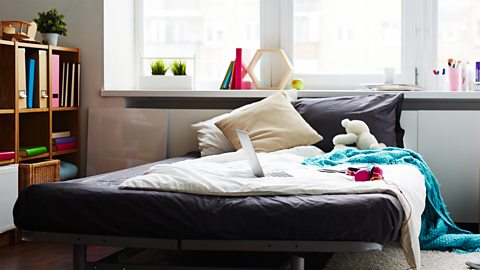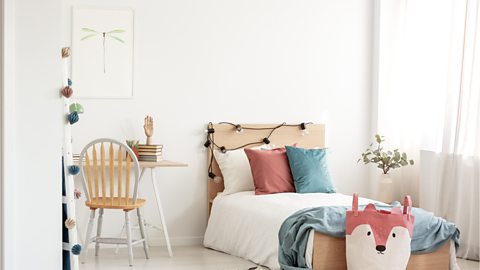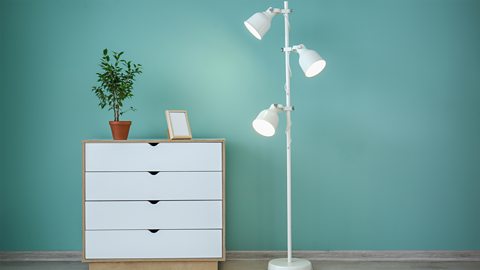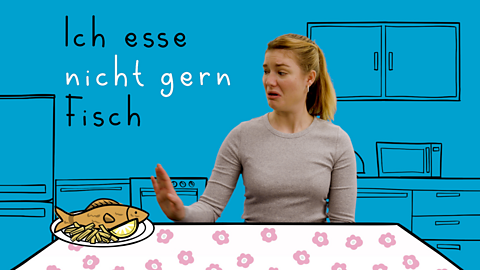Talking about your room in German
Hier ist mein Zimmer. Hereâs my room.
To describe your room you need to know what things are called.
For example, das Bett - bed, der Schreibtisch - desk, die Lampe - lamp.
If you want to say âthere isâ then you need to say es gibt.
Es gibt eine Lampe - There is a lamp.
Es gibt einen Kleiderschrank - There is a wardrobe.
Es gibt in meinem Zimmer ein Bett und einen Nachttisch - There is a bed and a bedside table in my room.
If you want to say a bit more about the things in your room then youâre going to need some adjectives too.
Mein Zimmer ist klein und unordentlich - My room is small and messy.
Das Bett ist ·É±đŸ±Ă - The bed is white
Es gibt ein gelbes Kissen - There is a yellow cushion.
Ich liebe mein gelbes Kissen.
With the phrases es gibt - 'there is', and in meinem Zimmer - 'in my room', you can say lots of great things about your room.
What is there in your room?

To ask someone what is in their room, use the following question:
- Was gibt es in deinem Zimmer? - What is there in your room?
To say what you have in your room, use es gibt (there is/are). To say a after es gibt you will need einen (masculine), eine (feminine) or ein (neuter).
- Es gibt ein Bett in meinem Zimmer - There is a bed in my room.
- Es gibt einen Kleiderschrank, eine Lampe und ein Bett in meinem Zimmer - There is a wardrobe, a lamp and a bed in my room.
- Es gibt einen Schreibtisch und ein Bett in meinem Zimmer - There is a desk and a bed in my room.


To say you donât have something, use keinen (masculine), keine (feminine) or kein (neuter).
- Es gibt keinen Schreibtisch und keine Kommode in meinem Zimmer â There is no desk and no chest of drawers in my room.

Look at the vocabulary below. Can you say what is in your room?
| German | English |
|---|---|
| der Kleiderschrank | wardrobe |
| der Schrank | cupboard |
| der Schreibtisch | desk |
| der Nachttisch | bedside table |
| der Teppich | carpet/rug |
| der StĂŒhl | chair |
| die Lampe | lamp |
| die Kommode | chest of drawers |
| das Bett | bed |
| das Etagenbett | bunk bed |
| das Poster | poster |
| das Regal | shelves |
To say you share a room, use the verb teilen.
- Ich teile - I share
- Ich teile ein Zimmer mit meiner Schwester - I share a room with my sister.
- Ich teile ein Zimmer mit meinem Bruder - I share a room with my brother.
Describing furniture and objects in your room

You can use adjectives to describe an object or piece of furniture in your room. To talk about your furniture, check the gender of the noun and use the correct form of mein (masculine and neuter) or meine (feminine).
- Mein Bett is Č”°ùŽÇĂ - My bed is big.
- Mein Kleiderschrank ist braun - My wardrobe is brown.
- Meine Lampe ist ·É±đŸ±Ă - My lamp is white.
- Mein Zimmer ist klein und ordentlich - My room is small and tidy.

Can you describe your room using the adjectives below?
| German | English |
|---|---|
| Č”°ùŽÇĂ | big |
| klein | small |
| ordentlich | tidy |
| unordentlich | untidy |
| rot | red |
| blau | blue |
| Č”°ùĂŒČÔ | green |
| gelb | yellow |
| ·É±đŸ±Ă | white |
| schwarz | black |
| grau | grey |
| orange | orange |
| braun | brown |
| rosa | pink |
| lila | purple |
Saying where things are in your room
To describe where things are in your room, you need to use prepositions. Prepositions are words and phrases like under and next to. They tell you where something is.
Prepositions in German often change the article (the/a) depending on whether the noun is masculine, feminine or neuter. This is because they are describing the static position of something in your room and therefore use the dative case. The table below shows how articles change in the dative case:
| the | a | |
|---|---|---|
| masculine | dem | einem |
| feminine | der | einer |
| neuter | dem | einem |
| plural | den |

- Der Stuhl ist unter dem Schreibtisch - The chair is under the desk.
- Die Lampe ist neben der Kommode - The lamp is next to the chest of drawers.
- Der Teppich ist zwischen dem Bett und der Kommode - The rug is between the bed and chest of drawers.
- Das Poster ist an der Wand - The poster is on the wall.

Use the vocabulary in the table below to talk about where things are in your room:
| German | English |
|---|---|
| unter | under |
| auf | on |
| in | in |
| neben | next to |
| zwischen | between |
| an | on |
| vor | in front of |
| Č”±đČ”±đČÔĂŒČú±đ°ù | opposite |
| hinter | behind |
Video
Watch this video then test your understanding in the short quiz!
What's in your room?
CHRISTINA: Willst du mein neues Zimmer sehen?
ANNA: Ja bitte. Du hast richtig GlĂŒck. Du hast ein schönes neues Schlafzimmer in einer neuen Wohnung.
CHRISTINA: Mein neues Zimmer ist gröĂer als mein alte Schlafzimmer. Aber ich muss das Zimmer mit meiner Schwester teilen.
ANNA: Gibt es ein Etagenbett oder zwei Betten?
CHRISTINA: Es gibt zwei Betten.
ANNA: Ich habe mein eigenes zimmer. Es ist aber sehr klein. Es gibt ein Bett.
CHRISTINA: Neben dem Fenster gibt es einen Schreibtisch.
ANNA: Richtig schön.
CHRISTINA: Ich mag am Schreibtisch malen. Vom Schreibtisch kann ich den Garten sehen.
ANNA: Wirklich schön. Von meinem Fenster kann ich die Strasse sehen.
CHRISTINA: Ja. Das Zimmer ist hell und Č”°ùŽÇĂ.
ANNA: Ja - echt nett.
CHRISTINA: Aber meine Schwester ist leider sehr unordentlich. Es gibt ĂŒberall Klamotten.
ANNA: Gibt es keinen Kleiderschrank?
CHRISTINA: Doch! Wir haben einen riesigen Kleiderschrank aber ihre Klamotten sind immer auf dem Boden.
ANNA: Ich bin sehr ordentlich. Meine Klamotten sind immer im Kleiderschrank.
CHRISTINA: Du bist richtig ordentlich.
ANNA: Ja kann sein.
CHRISTINA: Wir haben Beide GlĂŒck!
ANNA: Stimmt.
Translation
CHRISTINA: Do you want to see my new room?
ANNA: Yes, please. You are so lucky. You have a new bedroom in a new flat.
CHRISTINA: The room is bigger than my old bedroom. But I have to share the room with my sister.
ANNA: Is there a bunk bed or are there two beds?
CHRISTINA: There are two beds.
ANNA: I have my own room. But it is very small. There is one bed.
CHRISTINA: Near the window there is a desk.
ANNA: Really nice.
CHRISTINA: I like to do draw at the desk. From the desk I can see the garden.
ANNA: Really nice. From my window I can see the street.
CHRISTINA: Yes, the room is light and big.
ANNA: Yes, really nice.
CHRISTINA: But, unfortunately, my sister is really messy. There are clothes everywhere.
ANNA: Donât you have a wardrobe?
CHRISTINA: Of course! We have a huge wardrobe but her clothes are always on the floor.
ANNA: I am very tidy. My clothes are always in the wardrobe
CHRISTINA:You are really tidy!
ANNA: Yes, youâre right.
CHRISTINA: We are both lucky!
ANNA: Right.
Quiz
Game - FestiLingo: German. game
Visit the festival and practise German language skills in this game

More on Topics
Find out more by working through a topic
- count9 of 9

- count1 of 9
